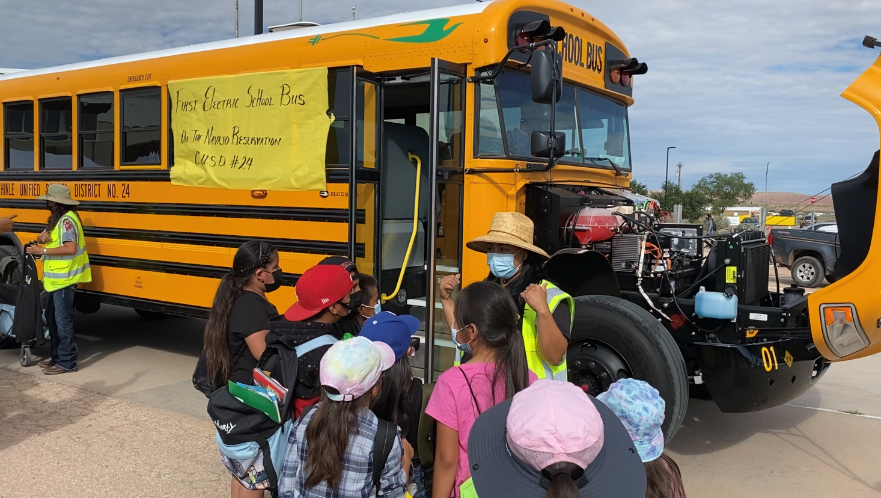Federal money is available to tribes interested in purchasing electric vehicles. Weekly listening sessions held by the Institute for Tribal Environmental Professionals are helping to get the word out.
By Melanie Lenart

Tribal entities interested in purchasing or supporting electric vehicles can look for assistance from the Institute for Tribal Environmental Professionals. ITEP program managers have been holding listening sessions on Wednesdays this month, inviting tribal nation employees to share ideas on what kind of services might be helpful.
Thinking of purchasing an electrified school bus or a fleet of them? ITEP might be able to help. Wondering which federal grants might be most worth pursuing when time is short and you only have capacity for one or two projects? That’s another area where they might be able to lend a hand. Electric cars and even bikes are other purchases that the institute could help tribal nations pursue.
This work is made possible by a grant focused on helping tribal nations, including tribal colleges and universities, bring electric vehicles to Native communities and build the infrastructure they need. The grant, from a private donor who wishes to remain anonymous, allows ITEP to select top priorities for spending with input from listening sessions and other activities.
The listening session on Wednesday, Feb. 8 attracted tribal nation employees with questions and suggestions about funding needs. About half a dozen employees from the National Renewable Energy Laboratory also attended to share information on programs and answer questions.
Andy Bessler, program manager for ITEP’s Tribal Clean Transportation Program, noted that the Environmental Protection Agency will be distributing about a billion dollars a year for the next four years to electrify school buses.
“They have three priorities,” he said. “One is tribes, one is rural communities and one is low-income communities. So rural tribal communities have a great chance of accessing these funds that are prioritized.”
For tribal nations interested in pursuing these or other options, the institute might be able to help tribal leaders and staff evaluate which grants might best serve their needs. If it’s identified as a need in the listening sessions, he said, the institute might even be able to direct some of its effort in the new program to help with grant proposal writing.
“One of the barriers that we’ve heard is that tribes really don’t have the capacity (to apply for grants)—there’s so much federal funding hitting the streets right now,” Bessler said.
Funds could also be available to support the purchase of electric vehicles for “on-demand transit,” where drivers can create routes daily depending on where individuals are seeking rides. National Renewable Energy Laboratory research suggests that on-demand transit helps low-income and older people, as well as people with health issues that make it challenging to get around.
Another idea floated during the session involved providing electric scooters to low-income citizens.
Just getting one or two electric vehicles into a tribal community, such as by providing “ride and drive” events, can help reduce skepticism about the value of electric vehicles, Bessler said.
“We did have a great communication with a rural Alaskan village on the Yukon river who just had their first Tesla arrive in the village,” he said. “They see it driving around, and seeing is believing because they see an electric vehicle driving around in negative-30-degree weather. So I think that type of ‘touch it and feel it’ is important. We’re looking at trying to help bring that model to tribal communities as well.”
Tribes might also be eligible for carbon credits and income tax breaks by employing electric vehicles.
Charging a hundred electric vehicles on a tribal nation at the same time could strain electricity output, potentially leading to blackouts, as a listener from the Catawba Nation of South Carolina pointed out.
Bessler noted that others have raised that issue as well. Because of this, he’s asked the Environmental Protection Agency to consider providing future funding for the purchase of solar panels and other renewable energy sources to support electric vehicles.
ITEP serves all tribal nations located in the United States from its home base at Northern Arizona University. It launched in 1992 with funding from the US Environmental Protection Agency “to act as a catalyst” among tribal governments, connecting them with federal, state and local governments as well as the private sector, using the university’s research and technical resources.
The next two listening sessions will be held at 3 p.m. Eastern time on Feb. 15 and Feb. 22. More information can be found here.
Melanie Lenart is a regular contributor to Native Science Report.
Story published February 13, 2023
• • •
Enjoyed this story? Enter your email to receive notifications.
